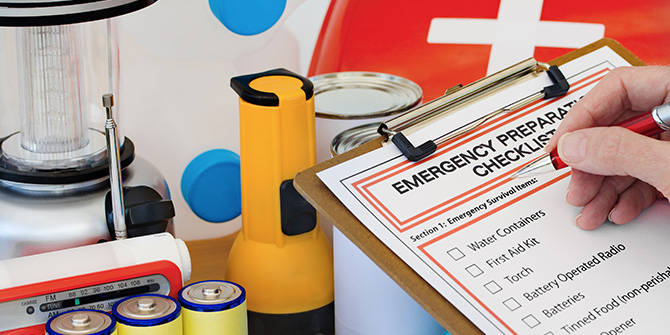
Hurricane strength rain or heavy winds could mean a weather emergency is at your door in no time and wreaking havoc on your life.
Make a plan and build a kit
Designate a meeting place for you and your family in case you need to evacuate. Then do a dry run. In addition, determine how everyone will contact each other in the event you become separated. Cell phone towers could be jammed or unavailable for a period of time. So be sure your plan considers the possibility of limited communication.
Assemble a “go-kit” — a collection of basic items you may need in an emergency. Kits should contain non-perishable food, water, prescriptions and other supplies, such as flashlights, paper maps and a battery-powered radio to last you for at least 72 hours.
In addition, visit your nearest CashPoints® ATM to withdraw cash before a storm hits. If the power goes out, ATMs will not be accessible.
Visit Ready.gov for a complete list of items to place in your kit.
Create a go-kit for important files
Once you’ve created a kit for your basic needs, do the same for your important documents. Create a financial go-kit using a small, fire-resistant safe that’s durable, lockable and portable in case you need to leave your home. Inside your safe use resealable plastic bags to hold your extra cash, account numbers, photocopy of passports and/or driver’s licenses and Social Security numbers.
If you’ve stored your computer files on a secure, external drive, be sure to add that to the box, too. Adding a back-up copy of important files to your safe deposit box is another way to ensure you can access important information if you become displaced.
Take inventory of your stuff
During a rapidly changing situation, having your important documents in one place and easily portable can make a big difference. If you haven’t already done so for insurance purposes, take the time now to video, photograph or document the valuables found inside and outside your home, including cars. Don’t forget items such as collectibles and electronics. Note the value, model and serial number if you can. Keep a copy of your list on your computer and a back-up copy on a secure, removable drive.
Stay informed with apps
Ensure your device is fully charged before weather arrives. This way you can periodically check in with friends and relatives and, stay on top of important news and alerts. Apps are useful for getting instructions on what you need to do before, during and after a weather event. Check your device’s app store for the Federal Emergency Management Agency (FEMA) app, which allows you to receive weather alerts for your area from the National Weather Service, find lifesaving safety tips and access disaster resources should you need them. Your local news stations may also have a similar weather alert app. Be sure to check with your carrier as data charges may apply.
A weather emergency requires you to react in a hurry. Hurricane season begins June 1. Prepare in advance to avoid losing or leaving behind something important.